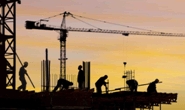Analysis

March 5, 2019
AGC: Construction Spending Saw Moderate Growth in 2018
Written by Sandy Williams
“Moderate and balanced growth” is evident across the residential, nonresidential and public construction sectors, although labor shortages continue to plague the industry, says an analysis of new government data by the Associated General Contractors of America
Construction spending dipped 0.6 percent in December to a seasonally adjusted annual rate of $1.29 trillion, but increased 1.6 percent from December 2017. Spending in 2018 as a whole increased 4.1 percent from 2017.
Contractors surveyed in January expect the dollar volume of projects available to expand in 2019 in all 13 project categories. AGC reports 79 percent of construction firms expect to add employees this year, but 78 percent reported difficulty finding qualified workers. Hiring is expected to remain difficult or become harder, said 68 percent of firms surveyed.
“The construction industry is one of the single greatest engines of middle-class job creation in the country,” said AGC CEO Stephen E. Sandherr. “If government officials won’t do more to prepare young adults for high-paying careers in construction, too many of those jobs will go unfilled.”
AGC reported the following regarding private residential and nonresidential spending and public construction spending:
Private residential spending slipped 1.4 percent from November to December and 1.3 percent compared to the December 2017 rate. For the full year, residential spending increased 3.3 percent from 2017, with gains of 5.2 percent for single-family and 0.7 percent for multifamily construction.
Private nonresidential spending grew 0.4 percent for the month and 3.4 percent compared to December 2017. The full-year total was 3.5 percent higher than in 2017. Among the largest private nonresidential segments, power construction (electric power plus oil and gas field and pipeline projects) gained 3.9 percent for the full year; commercial construction (retail, warehouse and farm structures) added 2.0 percent; manufacturing construction decreased 1.7 percent; and office construction increased 8.4 percent.
Public construction spending declined 0.6 percent for the month, but grew 4.2 percent compared to the year-earlier month. For 2018 as a whole, public construction rose 6.6 percent. The largest public category, highway and street construction, increased 4.2 percent. Educational construction, the next-largest segment, rose 3.8 percent for the year.







